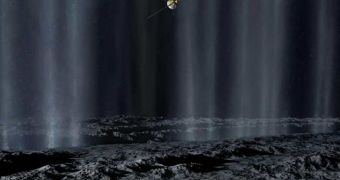The gas giant Saturn is surrounded by a large, protective layer of magnetic fields, called a magnetosphere, which protects its surface from the effects of solar flares and cosmic rays. This atmospheric layer is filled with electrically charged particles called plasma, which are affected by both the planet and the many moons that orbit the gas giant within the magnetosphere. Now, new data from the NASA Cassini spacecraft shows how Enceladus, Saturn's sixth-largest moon, punches holes and creates ripples through the plasma.
The space probe has only performed about 9 flybys of this peculiar moon since 2005, but researchers already believe that a liquid ocean may exist under its surface. The celestial body reflects about 100 percent of the light that hits it, and previous investigations have demonstrated that its south polar regions produce plume-like structures on occasions. When this happens, vapors of water and ice are emitted in space, fueling the E Ring around Saturn. The new Cassini data shows that the moon also caused interesting patterns of ripples and bubble in the plasma around Saturn.
The latest flyby that the NASA orbiter conducted took it just 15.5 miles (25 kilometers) above the surface of Enceladus, which is tremendously close. The scientific suite of instruments on the spacecraft showed that the plasma in the magnetosphere was being continuously soaked up by plumes the moon produced, as well as by the space object itself. Enceladus and the electrically charged particles rub against each other at speeds of about 67,000 miles per hour (108,000 kilometers per hour), and this is clearly visible in the “cavity” the moon's passing creates behind. The wake is eventually filled with particles from surrounding plasma.
“Eventually the plasma closes the gap downstream from Enceladus but our observations show that this isn't happening in a smooth, orderly fashion. We are seeing spiky features in the plasma that last between a few tens of seconds and a minute or two. We think that these might represent bubbles of low energy particles formed as the plasma fills the gap from different directions,” explains University College London (UCL) expert Sheila Kanani, who contributed to the new investigation.
“Enceladus is the source of most of the plasma in Saturn's magnetosphere, with ionized water and oxygen originating from the vents forming a big torus of plasma that surrounds Saturn. We may see these spiky features in the wake of Saturn's other moons as they interact with the plasma but, to date, we have only studied Enceladus in sufficient detail,” she concludes, quoted by Space.

 14 DAY TRIAL //
14 DAY TRIAL //